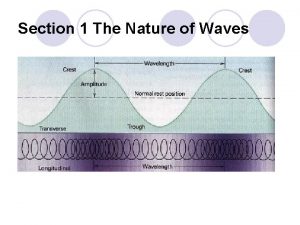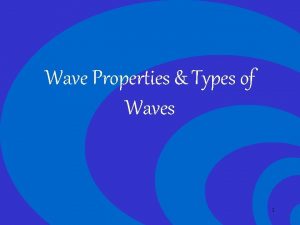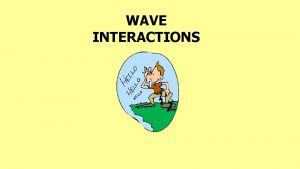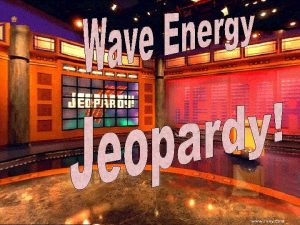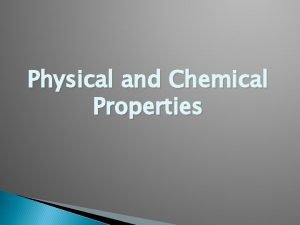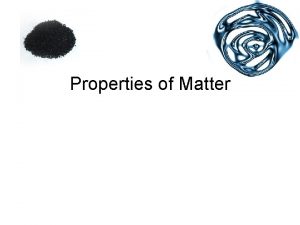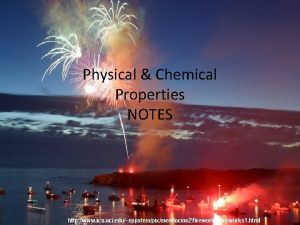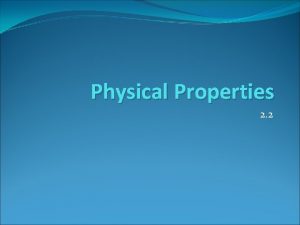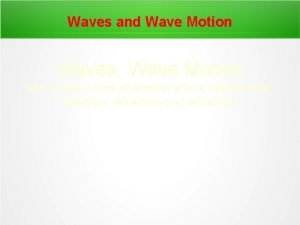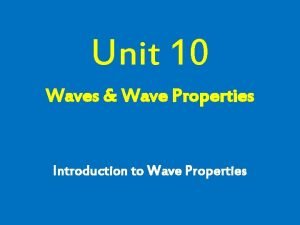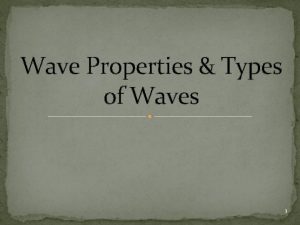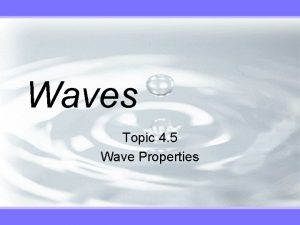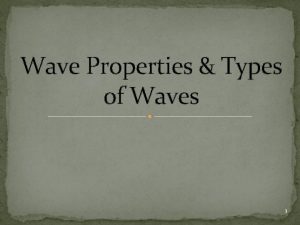Waves Wave Properties 1172014 Physical Waves Need a



















- Slides: 19

Waves & Wave Properties 11/7/2014

Physical Waves • Need a medium (material) to transmit energy through. • Light waves are an exception. They use the space-time fabric itself! • NOT position vs. time graphs! • Y vs. X (Real Shape frozen in time) • 2 Types Travelling • Standing • l A photograph, frozen in time, but showing all places, of a travelling water wave.

What Makes a Wave? A Disturbance in the Medium � Wave pulse (like Slinkies!) � Something that creates a displacement along the medium. � An energy input that “wiggles” the medium What is a Medium? � The medium has to be elastic, like Hooke’s Law. � All materials are made of atoms which are springy! � Space is a medium whose electromagnetic properties are springy. � Take AP Physics C to find out more about this. We will a little.

2 Types of Physical Waves Transverse Longitudinal �Energy transfer is 90 degrees to displacement of medium. �Makes the SHAPE of a sine/cosine wave. �A water wave is an example. �Energy transfer is ALONG the direction of displacement of the medium. �Think slinky pulse. �SOUND is our most well known example. �Air molecules don’t exert forces on each other until they bump straight into each other!

2 Types of Transverse Waves Travelling Standing � Energy transfers from one place to another via a medium. (TRANSMITS) � Energy spreads out in spheres, but are often limited to 1 D motion or 2 D. � Transmit energy at a speed: � Energy Reflects at an interface between two media. � Frequency of Energy input must match reflected wave. � Constructive Interference creates anti-nodes, . � Locations of destructive interference are Nodes � All other places are in between. � Created by Resonance. � Microwaves � V=fl=l/T

Standing Wave Terminology

Resonance � A condition when the INPUT energy frequency MATCHES the n. r. f. of a system/object. THINK MYTHBUSTERS EARTHQUAKE MACHINE � n. r. f. – “natural resonant frequency”. � Size (related to mass and density) � Shape (Square, Round, linear) � Material (as in bonds, IMFs, tension) � Density � Creates a standing wave by perfectly timed constructive and destructive interference. � If energy input matches energy output (due to friction or heat transfer) then it has a steady Amplitude (Etotal=constant) � Amplitude grows if more energy goes in than out. � Amplitude is “damped” if energy output is greater.

Resonance Graphs

Physical Waves and SHM � V=fl � v=l/T � l found from y vs. x � T found from y vs. t

DEMO: Water pendulum �Notice something oscillating in SHM like a pendulum can make a real wave (y vs. x). �Frequency/Period is determined by equation: �The wavelength depends on speed I pull paper!

Applying Wave Equation

Motion Graph (x vs. t)

Speed of Waves �Related to the medium they travel through. �V water ripples (capillary or “cat’s paw” waves)~1 -2 m/s �V sound in air = 330 m/s +0. 6 Tc �Depends on Density and “elasticity” �“Bulk Modulus” �Speed ~ √(Elasticity/Inertia) �V sound in steel= 6100 m/s!!! (17 x speed of sound in air!) �V of light= “c”= 3 x 10^8 m/s. (Approx. 1 million x faster)

Finding the speed of sound. Reflection from a Wall (ECHO) �Speed of sound is constant under constant conditions like temperature and moisture content. �Stand a known distance from a wall. �Clap hands. �Listen for echo, claps hands, listen clap hands listen. �Another person clap their hands along with initial clap and echo clap, making a rhythm. �This rhythm is related to period. Use a stopwatch to time 10 claps. Divide by 10, now you have Period and distance (2 x for echo travel) �V=distance over Time.

4 Wave Properties �Superposition- overlapping waves add displacements. �“Monsterwellen” photo, cargo ships �AM radio waves. “Wave Envelope” �Reflection- Waves reflect at the interface between 2 boundaries. (Often some of the wave transmits). �Refraction- Wave direction changes when passing through a different medium. �Interference- Waves overlapping “in-phase nl”, or “out of phase (l/2) can double in Amplitude or “cancel”.

Superposition • Displacements at all x positions add together, . • Causes a waveform. • Vowel Sounds on Oscilloscope • AEIOU

Reflection • Phet animation. “Waves on a String” • Think “Conservation of Energy”

Refraction • The path of a “wavefront” changes when it passes through a different medium with a different wave speed. • • Snell’s Law Animation using “Huygen’s Principle”- All waves reform as spheres at boundaries. http: //www. walter-fendt. de/ph 14 e/huygenspr. htm

Interference • When the path length difference between 2 waves is a WHOLE number mulltiple of a wavelength, then: • Constructive interference • If the path length difference is a multiple of ½ wavelength then: • Destructive Interference. • Speaker Demo • Diffraction Patterns
 Physical property and chemical property
Physical property and chemical property Electromagnetic waves are longitudinal waves true or false
Electromagnetic waves are longitudinal waves true or false Carbon dioxide temperature
Carbon dioxide temperature Difference between full wave and half wave rectifier
Difference between full wave and half wave rectifier Compare and contrast transverse and longitudinal waves
Compare and contrast transverse and longitudinal waves Half wave rectifier definition
Half wave rectifier definition Full wave rectifier example
Full wave rectifier example Earthquake p wave and swave travel time
Earthquake p wave and swave travel time Full wave rectified sine wave fourier series
Full wave rectified sine wave fourier series Wave wave repeating
Wave wave repeating The nature of waves chapter 10 section 1
The nature of waves chapter 10 section 1 Half-wave symmetry
Half-wave symmetry Mechanical waves and electromagnetic waves venn diagram
Mechanical waves and electromagnetic waves venn diagram Example mechanical waves
Example mechanical waves Transverse wave and longitudinal wave example
Transverse wave and longitudinal wave example Ability of two or more waves to combine and form a new wave
Ability of two or more waves to combine and form a new wave Differences between mechanical and electromagnetic waves
Differences between mechanical and electromagnetic waves Difference between mechanical and electromagnetic waves
Difference between mechanical and electromagnetic waves The wave chapter 13
The wave chapter 13 Is echolocation transverse or longitudinal
Is echolocation transverse or longitudinal















